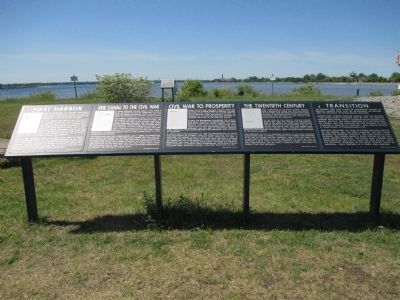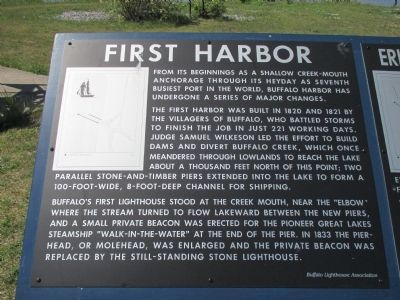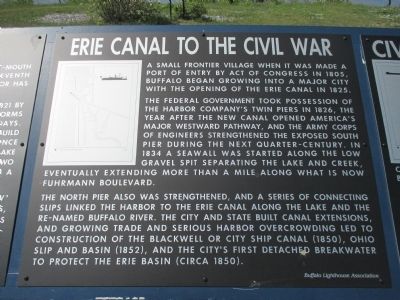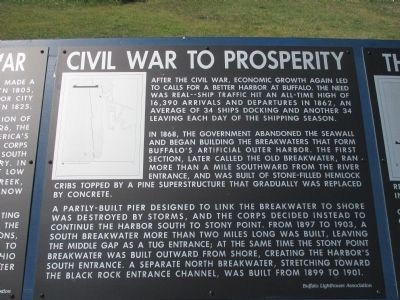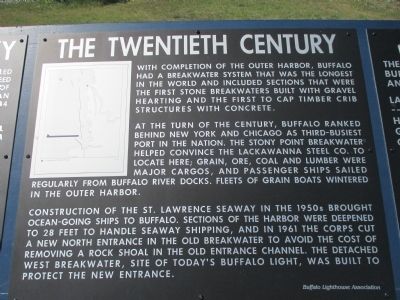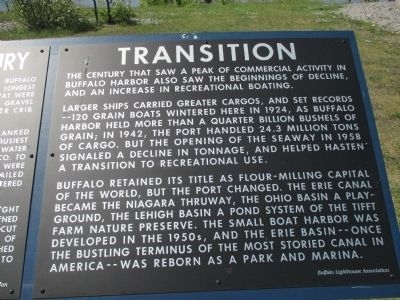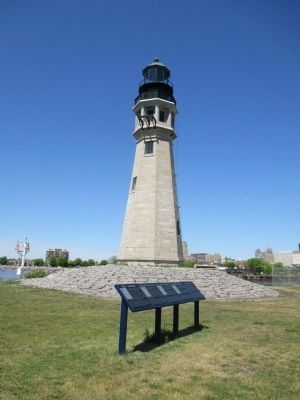First Ward in Buffalo in Erie County, New York — The American Northeast (Mid-Atlantic)
Buffalo Harbor
First Harbor
From its beginnings as a shallow creek-mouth anchorage through its heyday as seventh busiest port in the world, Buffalo Harbor has undergone a series of major changes.
The first harbor was built in 1820 and 1821 by the villagers of Buffalo, who battled storms to finish the job in just 221 working days. Judge Samuel Wilkeson led the effort to build dams and divert Buffalo Creek, which once meandered through lowlands to reach the lake about a thousand feet north of this point. Two parallel stone-and-timber piers extended into the lake to form a 100-foot-wide, 8-foot-deep channel for shipping.
Buffalo's first lighthouse stood at the creek mouth, near the "elbow" where the stream turned to flow lakeward between the new piers, and a small private beacon was erected for the pioneer Great Lakes steamship "Walk-in-the-Water" at the end of the pier. In 1833 the pier-head, or molehead, was enlarged and the private beacon was replaced by the still-standing stone lighthouse.
Erie Canal to the Civil War
A small frontier village when it was made a port of entry by act of Congress in 1805, Buffalo began growing into a major city with the opening of the Erie Canal in 1825.
The Federal Government took possession of the harbor company's twin piers in 1826, the year after the new canal opened America's major westward pathway, and the Army Corps of Engineers strengthened the exposed south pier during the next quarter-century. In 1834 a seawall was started along the low gravel spit separating the lake and creek, eventually extending more than a mile along what is now Fuhrmann Boulevard.
The North Pier also was strengthened, and a series of connecting slips linked the harbor to the Erie Canal along the lake and the re-named Buffalo River. The city and state built canal exensions, and growing trade and serious harbor overcrowding led to construction of the Blackwell or City Ship Canal (1850), Ohio Slip and Basin (1852), and the city's first detached breakwater to protect the Erie Basin (circa 1850).
Civil War to Prosperity
After the Civil War, economic growth again led to calls for a better harbor at Buffalo, the need was real--ship traffic hit an all-time high of 16,390 arrivals and departures in 1862, an average of 34 ships docking and another 34 leaving each day of the shipping season.
In 1868, the government abandoned the seawall and bean building the breakwaters that form the artificial outer harbor. The first section, later called the Old Breakwater, ran more than a mile southward from the river entrance, and was built of stone-filled Hemlock cribs topped by a pine superstructure that gradually was replaced by concrete.
A partly-built pier designed to link the breakwater to shore was destroyed by storms, and the Corps decided instead to continue the harbor south to Stony Point. From 1897 to 1903, a south breakwater more than two miles long was built, leaving the middle gap as a tug entrance; at the same time the Stony Point Breakwater was built outward from shore, creating the harbor's south entrance. A separate North Breakwater, stretching toward the Black Rock entrance channel, was built from 1899 to 1901.
The Twentieth Century
With completion of the outer harbor, Buffalo had a breakwater system that was the longest in the world and included sections that were the first stone breakwaters built with gravel hearting and the first to cap timber crib structures with concrete.
At the turn of the century, Buffalo ranked behind New York and Chicago as the third-busiest port in the nation. The Stony Point Breakwater helped convince the Lackawana Steel Co. to locate here; grain, ore, coal, and passenger ships sailed regularly from Buffalo River docks. Fleets of grain boats wintered in the outer harbor.
Construction of the St. Lawrence Seaway in the 1950s brought ocean-going ships to Buffalo. Sections of the harbor were deepened to 28 feet to handle Seaway shipping, and in 1961 the Corps cut a new north entrance in the old breakwater to avoid the cost of removing a rock shoal in the old entrance channel. The detached West Breakwater, site of today's Buffalo Light, was built to protect the new entrance.
Transition
The century that saw a peak of commercial activity in Buffalo Harbor also saw the beginnings of decline, and an increase in recreational boating.
Larger ships carried greater cargos, and set records--120 grain boats wintered here in 1924, as Buffalo Harbor held more than a quarter billion bushels of grain; in 1942, the port handled 24.3 million tons of cargo. But the opening of the Seaway in 1958 signalled a decline in tonnage, and helped hasten a transition to recreational use.
Buffalo retained its title as flour-milling capital of the world, but the port changed. The Erie Canal became the Niagara Thruway, the Ohio Basin a playground, the Lehigh Basin a pond system of the Tifft Farm Nature Preserve. The Small Boat Harbor was developed in the 1950s, and the Erie Basin--once the bustling terminus of the most storied canal in America--was reborn as a park and marina.
Erected by Buffalo Lighthouse Association.
Topics and series. This historical marker is listed in these topic lists: Communications • Industry & Commerce • Waterways & Vessels. In addition, it is included in the Lighthouses series list. A significant historical year for this entry is 1820.
Location. 42° 52.66′ N, 78° 53.38′ W. Marker is in Buffalo, New York, in Erie County. It is in the First Ward. Marker can be reached from Fuhrmann Boulevard, 1.3 miles north of The Skyway (New York State Route 5). Marker is a string of five panels. Marker is by the 1833 Buffalo Lighthouse which is at the end of the gated Coast Guard walkway, open 10A to sunset. The walkway begins at the north terminus of Fuhrmann Boulevard. Touch for map. Marker is at or near this postal address: 1 Fuhrman Boulevard, Buffalo NY 14203, United States of America. Touch for directions.
Other nearby markers. At least 8 other markers are within walking distance of this marker. Buffalo Water Intake, Horseshoe Reef Light (a few steps from this marker); Buffalo Main & Harbor Lights (a few steps from this marker); Buffalo Lightship (within shouting distance of this marker); The 1833 Buffalo Lighthouse (within shouting distance of this marker); International Shipmasters' Association (about 400 feet away, measured in a direct line); Penobscot-Morania Collision (about 500 feet away); The Lifeboat Station (approx. 0.2 miles away); The Coast Guard (approx. 0.2 miles away). Touch for a list and map of all markers in Buffalo.
Credits. This page was last revised on February 16, 2023. It was originally submitted on July 8, 2015, by Anton Schwarzmueller of Wilson, New York. This page has been viewed 782 times since then and 79 times this year. Photos: 1, 2, 3, 4, 5, 6, 7. submitted on July 8, 2015, by Anton Schwarzmueller of Wilson, New York.
